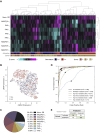Autofluorescence lifetime imaging classifies human B and NK cell activation state
- PMID: 40256783
- PMCID: PMC12006760
- DOI: 10.3389/fbioe.2025.1557021
Autofluorescence lifetime imaging classifies human B and NK cell activation state
Abstract
New non-destructive tools with single-cell resolution are needed to reliably assess B cell and NK cell function for applications including adoptive cell therapy and immune profiling. Optical metabolic imaging (OMI) is a label-free method that measures the autofluorescence intensity and lifetime of the metabolic cofactors NAD(P)H and FAD to quantify metabolism at a single-cell level. Here, we demonstrate that OMI can resolve metabolic changes between primary human quiescent and IL-4/anti-CD40 activated B cells and between quiescent and IL-12/IL-15/IL-18 activated NK cells. We found that stimulated B and NK cells had an increased proportion of free compared to protein-bound NAD(P)H, a reduced redox state, and produced more lactate compared to control cells. The NAD(P)H mean fluorescence lifetime decreased in the stimulated B and NK cells compared to control cells. Random forest models classified B cells and NK cells according to activation state (CD69+) based on OMI variables with an accuracy of 93%. Our results show that autofluorescence lifetime imaging can accurately assess B and NK cell activation in a label-free, non-destructive manner.
Keywords: B cells; Immune activation; NK cells; autofluorescence; imaging.
Copyright © 2025 Schmitz, Riendeau, Tweed, Rehani, Samimi, Pham, Jones, Maly, Contreras Guzman, Forsberg, Shahi, Hockerman, Ayuso, Capitini, Walsh and Skala.
Conflict of interest statement
Some authors are listed as inventors on patent applications related to this work filed by Wisconsin Alumni Research Foundation. CMC received honorarium for advisory board membership with Bayer, Nektar Therapeutics and Novartis, and has ownership interest with Elephas for advisory board membership. MCS receives honorarium for advisory board membership with Elephas. These entities had no input in the study design, analysis, manuscript preparation or decision to submit for publication. The remaining authors declare that the research was conducted in the absence of any commercial or financial relationships that could be construed as a potential conflict of interest.
Figures




Update of
-
Autofluorescence lifetime imaging classifies human lymphocyte activation and subtype.bioRxiv [Preprint]. 2023 Jan 23:2023.01.23.525260. doi: 10.1101/2023.01.23.525260. bioRxiv. 2023. Update in: Front Bioeng Biotechnol. 2025 Apr 04;13:1557021. doi: 10.3389/fbioe.2025.1557021. PMID: 36747690 Free PMC article. Updated. Preprint.
References
Grants and funding
LinkOut - more resources
Full Text Sources
Research Materials

